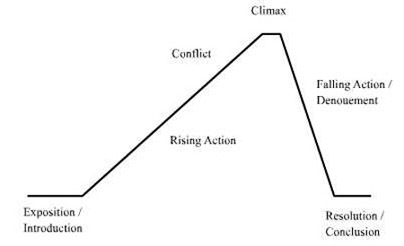When Words Collide 2015 Recap – Lessons from a Plot Workshop within an Unfamiliar Genre

Continuing on in my When Words Collide 2015 recap, the second workshop I attended was the Plot Workshop with Daniel Abraham (aka HLN Hanover, aka half of the pen name James S. A. Corey).
His definition of plot was the following:
The series of events that make up your story and the order in which they are presented.
Totally makes sense, right? This definition action accounts for non-linear presentations in fiction. More sense than this picture:

Source
Each story scene presented must deliver on the following three sections in order for the story to be tight:
Narrative: literal action going on in the scene.
Informative: what information do you need the reader to take away in order for this scene to make sense.
Functional: what the scene is doing in the story.
Now, this leads up to something that he said that really struck me. “A strong plot is independent of the story’s content.” What does this mean? It really doesn’t matter what is contained in the narrative side of the scene. The main focus for plot structure is on the functional side of the scene and whether the information presented ties together in the full functional outline of the story.
When we were given a chance to plot a short story in the morning, I piped up that we should do a mystery. Why did I say that? I don’t write mystery. At all, really. But I wanted to grow. I wanted to understand the structure and appeal in a narrative that I didn’t totally understand how to even start making.
The murder mystery began and we plotted about a talk show host finding out one of his guests was dead one hour before going on air. The first scene of the story broke down like this:
Scene one: hook
Narrative: Late night host finds out that guest for show is dead in the green room one hour before set to go live.
Informative: murder mystery, guest is victim, one hour to solve.
Functional: sets tone, introduces constraints.
I found this approach really neat. I hadn’t thought to break down scenes like this in order to truly see how each scene was required for the story. In the structure we had–a short story–we had to be economical about our scenes and make sure that each added to the story and moved it forward.
In the end, the functional side of the story scenes looked like this for the whole story:
Set tone, introduces constraints
Intro secondary characters, start false trail, introduce actual trail
First attempt begins
First attempt bears fruit
Addressing constraint, introducing second investigation (That protagonist may not know they are doing), misdirecting
Introducing clue or information that leads the first attempt to failure
First investigation fails
Changes focus to second investigation
Second attempt succeeds, climax of the story
Confirming for the reader the conclusion
This wasn’t to say that the whole workshop went smoothly. Group plotting is a horrendous activity because reconciling each person’s vision for the story takes a lot of effort and moderation that I hadn’t been expecting.
But, by plotting a mystery, I learned a lot about the needs of the genre and how it could be incorporated into other stories.

The post When Words Collide 2015 Recap – Lessons from a Plot Workshop within an Unfamiliar Genre appeared first on Anxiety Ink.
Anxiety Ink
- Kate Larking's profile
- 53 followers



